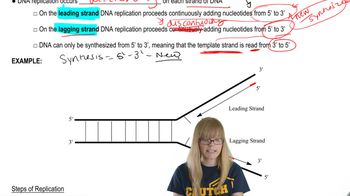Table of contents
- 1. Introduction to Genetics51m
- 2. Mendel's Laws of Inheritance3h 37m
- 3. Extensions to Mendelian Inheritance2h 41m
- 4. Genetic Mapping and Linkage2h 28m
- 5. Genetics of Bacteria and Viruses1h 21m
- 6. Chromosomal Variation1h 48m
- 7. DNA and Chromosome Structure56m
- 8. DNA Replication1h 10m
- 9. Mitosis and Meiosis1h 34m
- 10. Transcription1h 0m
- 11. Translation58m
- 12. Gene Regulation in Prokaryotes1h 19m
- 13. Gene Regulation in Eukaryotes44m
- 14. Genetic Control of Development44m
- 15. Genomes and Genomics1h 50m
- 16. Transposable Elements47m
- 17. Mutation, Repair, and Recombination1h 6m
- 18. Molecular Genetic Tools19m
- 19. Cancer Genetics29m
- 20. Quantitative Genetics1h 26m
- 21. Population Genetics50m
- 22. Evolutionary Genetics29m
8. DNA Replication
Overview of DNA Replication
Problem 36
Textbook Question
Textbook QuestionSuppose that future exploration of polar ice on Mars identifies a living microbe and that analysis indicates the organism carries double-stranded DNA as its genetic material. Suppose further that DNA replication analysis is performed by first growing the microbe in a growth medium containing the heavy isotope of nitrogen (¹⁴N) that the organism is then transferred to a growth medium containing the light isotope of nitrogen (¹⁴N) and that the nitrogen composition of the DNA is examined by CsCl ultracentrifugation and densitometry after the first, second, and third replication cycles in the ¹⁴N-containing medium. The results of the experiment are illustrated here for each cycle. The control shows the positioning of the three possible DNA densities. Based on the results shown, what can you conclude about the mechanism of DNA replication in this organism? (Hint: See the description of the Meselson and Stahl experiment on Section 6.1)
 Verified Solution
Verified SolutionThis video solution was recommended by our tutors as helpful for the problem above
Video duration:
5mPlay a video:
268
views
Was this helpful?



